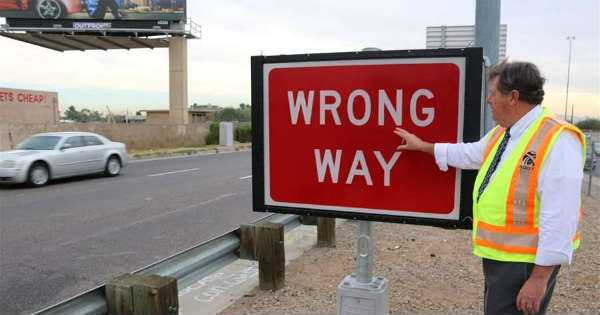States and cities have regulations in place to improve the barriers and signs around areas in the road that have been the site of wrong-way driving accidents. However, the best possible way to stop wrong-way driving is to keep drunk drivers off the road. Wrong-way driving is terrifying for other drivers. An individual is heading down the road and sees a vehicle heading straight toward them, and this can cause understandable panic. Fortunately, this type of accident doesn’t occur too often, thanks to medians and road signs, but wrong-way driving is still a serious issue in the U.S.

The US Department of Transportation (USDT) asserts that around 350 people die in the United States each year due to a wrong-way driving accident. While this doesn’t sound like a huge number, the statistic is shocking when you consider all the safety measures in place to ensure people drive the right way on the road. So why are there still so many wrong-way drivers?
Characteristics of Wrong-Way Drivers
The National Transportation Safety Board compiled a report recently in which they examined the data from wrong-way wrecks to look for trends that many of the accidents had in common. Some of the trends they discovered were:
- Drivers age 70 and over are unfairly seen as a significant cause of wrong-way accidents. However, senior drivers are likely to drive the wrong way at times, and this is mainly due to the fact that older drivers may have a hard time seeing road signs.
- Most wrong-way driving accidents occur when an automobile is coming onto an exit ramp. This could be because of unclear road signs or the driver’s unfamiliarity with the area.
- Wrong-way accidents are more likely to happen at night. Drivers who are fatigued, intoxicated, or struggling to see in the dark contribute to the fact that 78% of wrong-way collisions happen between the hours of 6 pm and 6 am.
- Wrong-way collisions happen more on the weekend than at any other time. This may be because people tend to consume more alcohol on the weekends.
- Wrong-way accidents occur 7 out of 9 in the lane that is closest to the median.
Most wrong-way drivers are drunk, and this is the main cause of these types of collisions. The National Transportation Safety Board conducted a meta-analysis and concluded that over half and as many as three-fourths of wrong-way collisions are because of a drunk driver. Intoxicated drivers were found to have a blood-alcohol level of .15 or more, which is almost twice the legal limit.
Wrong-Way Accidents Will Be Reduced by Stopping Drunk Driving
Most cities and states work to improve road conditions to reduce accidents. However, it appears that eliminating drunk driving is the most effective way to stop wrong-way collisions. While this is not an easy task, lawmakers should still work to keep intoxicated drivers off the road.
Many intoxicated drivers have been arrested for a DUI, and NTSB suggests requiring individuals with DUI convictions to use an alcohol ignition interlock device or a device installed in their vehicles to detect alcohol levels.
These devices will keep an individual from operating a vehicle if their blood alcohol level is above the legal limit. Educating the public about the consequences of driving drunk and imposing harsher sentencing for DUI can also discourage wrong-way driving, prevent injuries, and save lives.
Seek Legal Advice
If you’ve been injured in a wrong-way collision, you should work with an attorney to recover damages if your vehicle was ruined or you had to get treatment for serious injuries. A qualified auto accident lawyer can review the information pertaining to your accident and work with the at-fault party’s insurance company to make sure you get a fair settlement.

